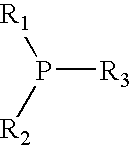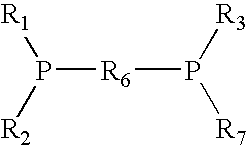Bleaching and brightness stabilization of lignocellulosic materials with water-soluble phosphines or phosphonium compounds
a technology of phosphonium compounds and lignocellulosic materials, which is applied in the field of bleaching and brightness stabilization of lignocellulosic materials, can solve the problems of reducing the yield of pulps by 2-5%, producing effluents with high chemical oxygen demand, and less effective than alkaline hydrogen peroxide bleaching in terms of maximum brightness gain
- Summary
- Abstract
- Description
- Claims
- Application Information
AI Technical Summary
Problems solved by technology
Method used
Image
Examples
example 1
[0094] Chelated spruce TMP (% ISO brightness=58.2) was treated with 1.0% (on OD pulp) of tris(hydroxymethyl)phosphine (THP) at 1.5% consistency, 90.degree. C. for 3 h at various pHs according to the general procedure A disclosed above. Table 1 shows the increases of the ISO brightness of the pulps after treatment with THP over a wide pH range.
1TABLE 1 % ISO Brightness of the Spruce TMP after Treatment with 1.0% (on OD pulp) of THP at Various pHs pH % ISO Brightness 4.3 .+-. 0.2 64.8 5.3 .+-. 0.2 64.7 6.3 .+-. 0.2 64.0 7.3 .+-. 0.2 64.3 8.3 .+-. 0.2 64.2 9.3 .+-. 0.2 63.6 10.3 .+-. 0.2 62.5
example 2
[0095] Chelated spruce TMP (% ISO brightness=58.2) was treated with 1.0% (on OD pulp) of THP at 90.degree. C., pH 5.3.+-.0.2 for 3 h at various consistencies according to the general procedure A disclosed above. Table 2 shows that bleaching of the pulps by the said treatment can be achieved at various consistencies.
2TABLE 2 % ISO Brightness of the Spruce TMP after Treatment with THP at Various Consistencies Consistency (%) % ISO Brightness 1.5 64.7 5.0 65.0 10 64.9 20 64.6
example 3
[0096] Chelated spruce TMP (% ISO brightness=58.2) was treated with 1.0% and 2.0% (on OD pulp) of tetrakis(hydroxymethyl)phosphonium chloride (THPC) (from Aldrich), [P(CH.sub.2OH).sub.4]Cl, and tetraethylphosphonium chloride (TEPC) (from Aldrich), [P(CH.sub.2CH.sub.3).sub.4]Cl, respectively, at 1.5% consistency, 90.degree. C., pH 5.3.+-.0.2 for 3 h according to the general procedure A disclosed above. Table 3 shows that bleaching of the pulp can be achieved by treatment with THPC, but not with TEPC-a quaternary phosphonium compound containing no phosphorus hydroxymethyl bond / linkage (P--CH.sub.2OH).
3TABLE 3 % ISO Brightness of the Spruce TMP after Treatment with THPC and TEPC Amount of the phosphonium % ISO Brightness of the % ISO Brightness of the compound (% on OD pulp) THPC-treated Pulp TEPC-treated Pulp 1.0 62.5 57.7 2.0 64.4 57.5
PUM
| Property | Measurement | Unit |
|---|---|---|
| Fraction | aaaaa | aaaaa |
| Fraction | aaaaa | aaaaa |
| Fraction | aaaaa | aaaaa |
Abstract
Description
Claims
Application Information
 Login to View More
Login to View More - R&D
- Intellectual Property
- Life Sciences
- Materials
- Tech Scout
- Unparalleled Data Quality
- Higher Quality Content
- 60% Fewer Hallucinations
Browse by: Latest US Patents, China's latest patents, Technical Efficacy Thesaurus, Application Domain, Technology Topic, Popular Technical Reports.
© 2025 PatSnap. All rights reserved.Legal|Privacy policy|Modern Slavery Act Transparency Statement|Sitemap|About US| Contact US: help@patsnap.com



